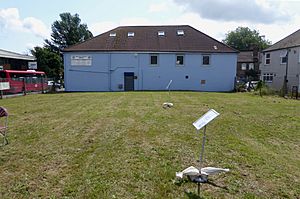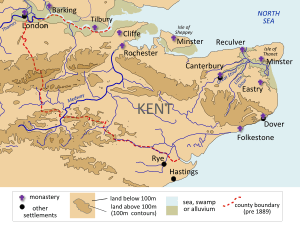Fordcroft Anglo-Saxon cemetery facts for kids

The location of the cemetery
|
|
| Lua error in Module:Location_map at line 420: attempt to index field 'wikibase' (a nil value). | |
| Location | Orpington, London Borough of Bromley |
|---|---|
| Type | Anglo-Saxon inhumation and cremation cemetery |
The Fordcroft Anglo-Saxon cemetery was an ancient burial ground. It's found in Orpington, a town in South East London, South-East England. This cemetery dates back to the Middle Anglo-Saxon period. It shows how people were buried during that time in early Anglo-Saxon England.
At Fordcroft, people were buried in two ways: some were buried whole (this is called inhumation), and others were cremated (their bodies burned) before burial.
Archaeologists from the local Orpington Museum started digging here in 1965. They thought they would find Roman-British remains. But they found this cemetery instead and decided to explore it. They worked for four years, finishing in 1968.
Contents
Where is the Cemetery Located?
The cemetery is in Orpington, near the town of St Mary Cray. It's located between Bellefield Road and Poverest Road, close to the A224 road. The River Cray starts about half a mile south of the cemetery. The river itself flows just 200 metres away from the site.
The land where the cemetery was found was about 1/8 of an acre. The soil there is mostly "brick-earth," which sits on top of gravel from the valley floor.
The closest old settlement is a farm called Poverest. Its name has been around since the early 1300s. This area was farmland between two villages until the mid-1800s. Then, it became a suburban area as more houses were built. Some old Victorian cottages were built right on top of the cemetery. These houses were later torn down in the 1900s. Before the archaeologists started digging, the site was "overgrown with weeds and littered with rubbish."
What Was Anglo-Saxon Kent Like?
The Anglo-Saxon period began in the 400s CE. During this time, the area that became Kent changed a lot. Before this, it was part of Roman Britain, ruled by the Roman Empire. But after Roman rule ended around 410 CE, many Roman ways of life disappeared. They were replaced by the new Anglo-Saxon culture.
Later Anglo-Saxon stories say that Germanic-speaking tribes from northern Europe, like the Angles, Saxons, and Jutes, invaded Britain. However, archaeological finds show that Anglo-Saxon and Roman-British cultures often mixed together.
The name Kent comes from the Old English language. It was based on an older Celtic name, Cantii. At first, Kent only referred to the area east of the River Medway. But by the end of the 500s, it included areas to the west as well. The Kingdom of Kent was the first Anglo-Saxon kingdom mentioned in history. By the late 500s, it was very powerful. It controlled many parts of southern and eastern Britain.
Kent had strong trade links with Francia (modern-day France) at this time. The Kentish royal family even married members of Francia's Merovingian dynasty, who were already Christian. Kentish King Æthelberht was a powerful ruler. He converted to Christianity in the early 600s. This happened because Augustine of Canterbury and the Gregorian mission came to England. They were sent by Pope Gregory to replace England's pagan beliefs with Christianity. The Fordcroft cemetery was in use during this important time.
Kent has many ancient burial sites from the Early Medieval period. People started digging up Anglo-Saxon graves in Kent in the 1600s. These early explorers were called antiquarians. Over the centuries, this interest grew into more scientific archaeological studies. Famous archaeologists like Bryan Faussett and Charles Roach Smith did a lot of research in Kent.
What Did Archaeologists Find?
The Fordcroft cemetery had both cremation and inhumation burials. These two types of burials were mixed together. This made archaeologists think that both methods were used at the same time. In total, archaeologists found 19 cremations and 52 inhumations. Based on the items found in the graves, experts believe the cemetery was used between about 450 and 550 CE. The artifacts and burial styles were similar to those found around the Thames Valley.
There is also evidence of Roman-British people living nearby. Coins found show that they were there until at least 370 CE. One archaeologist, Tester, thought that the Anglo-Saxons might have chosen Fordcroft as a cemetery site on purpose because the Romans had been there. However, he also thought it might have just been a coincidence.
Many of the skeletons were very old and had decayed a lot. But in many cases, the teeth and long bones were still good enough. This allowed scientists to figure out the age and sex of the people buried there. Most of the buried bodies had their heads facing west. But some were facing south. Most of the graves were roughly rectangular with rounded corners. However, some were not as neat.
Because of buildings put up in the 1800s, archaeologists couldn't tell exactly where the Anglo-Saxon ground level was. This meant they couldn't know how deep the graves had originally been dug.
How Was the Cemetery Discovered?
In the 1940s, workers were digging a trench in Bellefield Road, next to the cemetery site. They found pieces of Roman-British pottery. An archaeologist named A. Eldridge wrote about this discovery. He thought there might have been a Roman-British building nearby.
In the 1960s, local archaeologists decided to check this idea. They investigated the empty site at Fordcroft. Houses on the site had been torn down. Digging began in July 1965. The Orpington Museum sponsored the work. The London Borough of Bromley, which owned the land, gave permission. The council even provided a mechanical digger to clear away rubble.
M. Bowen, the curator of Orpington Museum, helped organize much of the investigation. The items found at the site were first stored at the museum.
The first things found were Roman-British, but no Roman buildings were discovered. Soon after, an Anglo-Saxon cremation urn was found. Then, several inhumation burials appeared. This showed that the site was actually an Anglo-Saxon cemetery. From then on, finding out more about the cemetery became the main goal. In the first two years of work, 16 cremations and 29 inhumations were found.
At the time, this was the first "well-authenticated" proof of Anglo-Saxon settlement along the River Cray. Older people who used to live in the cottages on the site visited the dig. They shared "likely and amusing comments" when they learned they had been living above an ancient cemetery!
A small test pit was dug in the garage of a nearby house, No. 17 Poverest Road. Another grave was found there. Archaeologists believe that more burials might be under that house. The team dug in all the available areas. However, they could not dig under the roads around the site. They also couldn't dig under the houses to the east and west.


